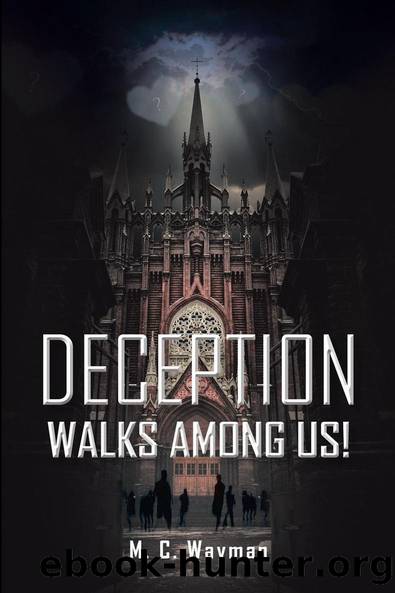Deception Walks among Us! by M. C. Wayman

Author:M. C. Wayman [Wayman, M. C.]
Language: eng
Format: epub
Tags: Social Science, Discrimination
ISBN: 9781098094010
Google: 1b5LEAAAQBAJ
Publisher: Christian Faith Publishing, Inc.
Published: 2021-10-29T04:26:22+00:00
* * *
7 Ian Caso (President and Publisher), Gilbert Bailon (Editor), and Tod Roberson (Editorial Page Editor), Opinion, âBelieve Him on The Transition Question,â (St. Louis Post Dispatch, www.STLToday.com, September 27, 2020), A16.
Chapter 8
The Blacksâ Neighborhoods of the Past
The churches within the neighborhoods, in conjunction with the home environment, are the second models of how relationships are built toward individuals of color as young children develop into adulthood.
While in high school I discovered, based on my relationship with a White friend from the fourth grade, that it appeared to me that White peopleâs hatred was not based on the characteristics of Black people but on the color of their skin, and Black peopleâs hatred was based on the White societyâs treatment of them. Because White society believed that Blacks could not learn, therefore, Blacks were suppressed based on White peopleâs superiority.
Black parents and the generation before them, based on their religious beliefs and background, could forgive White society for the injustices placed upon them, and they moved on. Today, young Blacks will not forgive, and this frightens many Southern Whites and a few Northern Whites too.
Most people in the neighborhoods across the United States of America recognize the word church as a building where various spiritual programs are offered to men, women, and children. From the Christianâs viewpoint, the church emphasizes the calling to minister a group of people who continue Christâs ministry to others, inside and outside the fellowship of believers. The church as a family emphasizes its calling to be a loving community, rich with supportive relations in which individuals can grow to maturity. The church also emphasizes our calling to be a holy communityâa beacon of light in a dark, sinful world, in order to change the community. The church is people who have made a commitment to Christ for the rest of their lives. Therefore, an individual who is born again is intended by God to have a place in Godâs extended familyâthe church.
During the eighteenth and nineteenth centuries, the ministers or pastors were the teachers, the mediators of church affairs, and the family counselors for their congregation. Therefore, the church was the extended family for many people of color, especially for the Black community.
Before the megachurches came into the picture, there were the small communitiesâ churches with congregations between one hundred and three hundred members, playing an important part within their community in delivering the word, helping those in need, visiting the sick in hospitals, nursing homes, and those unable to leave their home due to the severities of illness. The minister knew his/her congregation and the communityâs trouble spots and had a better understanding of his/her membersâ concerns (faith, marriage, finances, etc.). Also within the church, there were deacons and elders who could counsel young Black men about walking in faith and pass on their own experiences, knowledge, and wisdom on how to be a man. It was believed, and it is still true, that only a man could tell a young man how to become a manâa woman could not because she had never walked in a grown manâs footsteps.
Download
This site does not store any files on its server. We only index and link to content provided by other sites. Please contact the content providers to delete copyright contents if any and email us, we'll remove relevant links or contents immediately.
| Anthropology | Archaeology |
| Philosophy | Politics & Government |
| Social Sciences | Sociology |
| Women's Studies |
Nudge - Improving Decisions about Health, Wealth, and Happiness by Thaler Sunstein(7255)
iGen by Jean M. Twenge(5166)
The Fire Next Time by James Baldwin(5024)
Adulting by Kelly Williams Brown(4239)
The Hacking of the American Mind by Robert H. Lustig(4092)
The Sports Rules Book by Human Kinetics(4079)
The Ethical Slut by Janet W. Hardy(4042)
Captivate by Vanessa Van Edwards(3732)
Mummy Knew by Lisa James(3522)
In a Sunburned Country by Bill Bryson(3374)
The Worm at the Core by Sheldon Solomon(3327)
Ants Among Elephants by Sujatha Gidla(3282)
Suicide: A Study in Sociology by Emile Durkheim(2906)
The Slow Fix: Solve Problems, Work Smarter, and Live Better In a World Addicted to Speed by Carl Honore(2843)
The 48 laws of power by Robert Greene & Joost Elffers(2816)
Humans of New York by Brandon Stanton(2690)
Handbook of Forensic Sociology and Psychology by Stephen J. Morewitz & Mark L. Goldstein(2604)
The Happy Hooker by Xaviera Hollander(2586)
The Tipping Point by Malcolm Gladwell(2563)
